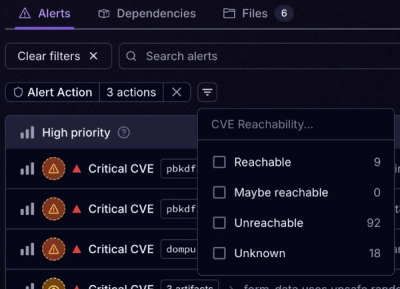
Product
Announcing Socket Fix 2.0
Socket Fix 2.0 brings targeted CVE remediation, smarter upgrade planning, and broader ecosystem support to help developers get to zero alerts.
broccoli-debug
Advanced tools
Utility for build pipeline authors to allow trivial debugging of the Broccoli pipelines they author.
Heavily inspired by @stefanpenner's
broccoli-stew's debug's helper,
but improved in a few ways:
.png's as utf8 text).To allow consumers to debug the internals of various stages in your build pipeline,
you create a new instance of BroccoliDebug and return it instead.
Something like this:
var BroccoliDebug = require('broccoli-debug');
let tree = new BroccoliDebug(input, `ember-engines:${this.name}:addon-input`);
Obviously, this would get quite verbose to do many times, so we have created a shortcut to easily create a number of debug trees with a shared prefix:
let debugTree = BroccoliDebug.buildDebugCallback(`ember-engines:${this.name}`);
let tree1 = debugTree(input1, 'addon-input');
// tree1.debugLabel => 'ember-engines:<some-name>:addon-input'
let tree2 = debugTree(input2, 'addon-output');
// tree2.debugLabel => 'ember-engines:<some-name>:addon-output
Folks wanting to inspect the state of the build pipeline at that stage, would do the following:
BROCCOLI_DEBUG=ember-engines:* ember b
Now you can take a look at the state of that input tree by:
ls DEBUG/ember-engines/*
interface BroccoliDebugOptions {
/**
The label to use for the debug folder. By default, will be placed in `DEBUG/*`.
*/
label: string
/**
The base directory to place the input node contents when debugging is enabled.
Chooses the default in this order:
* `process.env.BROCCOLI_DEBUG_PATH`
* `path.join(process.cwd(), 'DEBUG')`
*/
baseDir: string
/**
Should the tree be "always on" for debugging? This is akin to `debugger`, its very
useful while actively working on a build pipeline, but is likely something you would
remove before publishing.
*/
force?: boolean
}
class BroccoliDebug {
/**
Builds a callback function for easily generating `BroccoliDebug` instances
with a shared prefix.
*/
static buildDebugCallback(prefix: string): (node: any, labelOrOptions: string | BroccoliDebugOptions) => BroccoliNode
constructor(node: BroccoliNode, labelOrOptions: string | BroccoliDebugOptions);
debugLabel: string;
}
git clone git@github.com:broccolijs/broccoli-debug.gitcd broccoli-debugyarnyarn testFAQs
Enable easy debugging of broccoli pipelines with broccoli-debug!
The npm package broccoli-debug receives a total of 96,055 weekly downloads. As such, broccoli-debug popularity was classified as popular.
We found that broccoli-debug demonstrated a not healthy version release cadence and project activity because the last version was released a year ago. It has 3 open source maintainers collaborating on the project.
Did you know?

Socket for GitHub automatically highlights issues in each pull request and monitors the health of all your open source dependencies. Discover the contents of your packages and block harmful activity before you install or update your dependencies.

Product
Socket Fix 2.0 brings targeted CVE remediation, smarter upgrade planning, and broader ecosystem support to help developers get to zero alerts.

Security News
Socket CEO Feross Aboukhadijeh joins Risky Business Weekly to unpack recent npm phishing attacks, their limited impact, and the risks if attackers get smarter.

Product
Socket’s new Tier 1 Reachability filters out up to 80% of irrelevant CVEs, so security teams can focus on the vulnerabilities that matter.